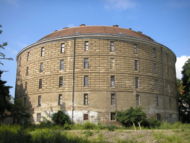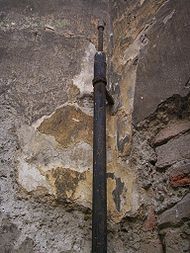
Narrenturm (hospital)
Encyclopedia


Vienna
Vienna is the capital and largest city of the Republic of Austria and one of the nine states of Austria. Vienna is Austria's primary city, with a population of about 1.723 million , and is by far the largest city in Austria, as well as its cultural, economic, and political centre...
is continental Europe's oldest building for the accommodation of mental patients. Built in 1784, it is next to the site of the old Vienna General Hospital
Vienna General Hospital
The Vienna General Hospital is the University medical center of the city of Vienna, Austria. The AKH is the largest hospital of Austria and Europe, the second largest hospital in the world, and at 85-m high is one of the tallest hospital buildings in the world...
(today a university campus), and is now home to the Federal Pathologic-Anatomical Museum Vienna .
The building
The Narrenturm was constructed in 1784, under Emperor Joseph IIJoseph II, Holy Roman Emperor
Joseph II was Holy Roman Emperor from 1765 to 1790 and ruler of the Habsburg lands from 1780 to 1790. He was the eldest son of Empress Maria Theresa and her husband, Francis I...
, by Isidore Canevale. It consisted of a five-storey, fortress-like circular building with 28 rooms and a ring of slit windows, plus a central chamber aligned north-south. There were in total 139 individual cells for the inmates. The building of the Narrenturm was prompted by the discovery of underground dungeons used by the Capuchin
Order of Friars Minor Capuchin
The Order of Friars Minor Capuchin is an Order of friars in the Catholic Church, among the chief offshoots of the Franciscans. The worldwide head of the Order, called the Minister General, is currently Father Mauro Jöhri.-Origins :...
monks of Vienna for housing their mentally ill brethren; another factor was that Joseph II had learned about similar institutions in France
France
The French Republic , The French Republic , The French Republic , (commonly known as France , is a unitary semi-presidential republic in Western Europe with several overseas territories and islands located on other continents and in the Indian, Pacific, and Atlantic oceans. Metropolitan France...
during his travels there. The construction of the Narrenturm points to a new attitude towards the mentally ill – they began to be distinguished from the rest of society, and not simply classified among the general category of "the poor".
Each cell had strong, barred doors as well as chains for shackling unrestrained inmates. With its barracks-like appearance, the tower was a visible expression of the segregation, stigmatisation and criminalisation of socially deviant forms of behaviour.
By the late 1790s the tower had already been made fully obsolete by innovations in the treatment of mental patients. Despite appearances, the Narrenturm was not an implementation of Jeremy Bentham
Jeremy Bentham
Jeremy Bentham was an English jurist, philosopher, and legal and social reformer. He became a leading theorist in Anglo-American philosophy of law, and a political radical whose ideas influenced the development of welfarism...
's hypothetical panopticon
Panopticon
The Panopticon is a type of building designed by English philosopher and social theorist Jeremy Bentham in the late eighteenth century. The concept of the design is to allow an observer to observe all inmates of an institution without them being able to tell whether or not they are being watched...
, as the cells could not be monitored from a central post.
The tower's round shape is the source of the Viennese slang word Gugelhupf
Gugelhupf
A Gugelhupf or Gugelhopf is a southern German, Austrian, Swiss and Alsatian term for a marble cake or Bundt cake. The part "Gugel-" is a variation of the Middle High German word Kugel...
(a type of round cake) for mental asylums and psychiatric clinics.
When it was first built, the Narrenturm had a lightning rod
Lightning rod
A lightning rod or lightning conductor is a metal rod or conductor mounted on top of a building and electrically connected to the ground through a wire, to protect the building in the event of lightning...
or "lightning catcher" installed on the roof ridge. Two of the supporting fixtures can still be seen in the inner chamber. Václav Prokop Diviš
Václav Prokop Diviš
Václav Prokop Diviš was a Czech priest, theologian and natural scientist.Diviš was born March 26 1698 in Helvíkovice, Bohemia . It has been claimed that the lightning rod he erected in 15 June 1754 was invented independently of Benjamin Franklin, but this has been disputed by other scholars...
, a clergyman in Přímětice near Znojmo
Znojmo
Znojmo is a city in the South Moravian Region of the Czech Republic, near the border with Lower Austria, connected to Vienna by railway and road . The royal city of Znojmo was founded shortly before 1226 by King Ottokar I on the plains in front of Znojmo Castle...
, created the world's first earthed conductor in his garden in 1754; it is sometimes claimed that he did this independently of Benjamin Franklin
Benjamin Franklin
Dr. Benjamin Franklin was one of the Founding Fathers of the United States. A noted polymath, Franklin was a leading author, printer, political theorist, politician, postmaster, scientist, musician, inventor, satirist, civic activist, statesman, and diplomat...
, who invented the lightning rod in 1753. At this time some people believed electricity to have health benefits – however, it is not known whether the lightning rod in the Narrenturm, whose remnants are probably the oldest surviving pieces of such a device in the world, was used in the treatment of patients.
The museum
The tower is currently home to the Federal Pathologic-Anatomical Museum, founded by Emperor Francis IIFrancis II, Holy Roman Emperor
Francis II was the last Holy Roman Emperor, ruling from 1792 until 6 August 1806, when he dissolved the Empire after the disastrous defeat of the Third Coalition by Napoleon at the Battle of Austerlitz...
in 1796 as the "Museum of the Pathologic-Anatomical Institute". It has been a national museum (Bundesmuseum) since 1974.
Electro-Pathological Museum
Parts of the former Electro-Pathological Museum, founded in 1936 by Stefan Jellinek, are housed here. Jellinek was forced to leave the country in 1939, but regained his old collection after the war. A new exhibition was created after Jellinek's death in 1968 by his colleague Franz Maresch. In the 1980s the Technisches Museum Wien
Technisches Museum Wien
The Technisches Museum Wien lies in Vienna , in Penzing district, on the Mariahilferstraße 212....
took over a large part of the collection, while its preserved human and animal exhibits were transferred to the Pathologic-Anatomical Museum.
External links
See also
- History of psychiatric institutionsHistory of psychiatric institutionsThe story of the rise of the lunatic asylum and its gradual transformation into, and eventual replacement by, the modern psychiatric hospital, is also the story of the rise of organized, institutional psychiatry...

